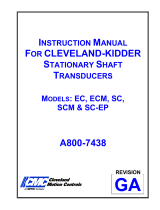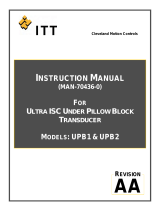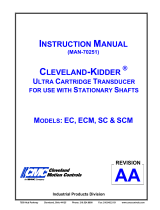Page is loading ...

INSTRUCTION NUMBER: AO-70165 1 of 9
CLEVELAND-KIDDER® SLIM CELL
TRANSDUCER
INSTRUCTION MANUAL . . . TYPE SLIM CELL TRANSDUCER

INSTRUCTION NUMBER: AO-70165 2of 9
1.0 GENERAL INFORMATION
1.1 RECEIVING AND UNPACKING
Handle and unpack the equipment carefully.
Immediately upon arrival, check the shipment against
the packing list. Any damage should be reported
immediately to the carrier and to the nearest CMC
representative.
Equipment that will not be installed immediately
should be stored in a clean, dry location. Precautions
should be taken to prevent moisture, dust and dirt
from accumulating in storage and installation areas
1.2 PRECAUTIONS
1.2.1 Shipping - It is recommended that the sensing
roll be removed when the machine is shipped with the
transducers mounted. The shock and vibration
transmitted to the transducers by the sensing roll
during transporting can damage them.
1.2.2 Roll Balance - The sensing roll should be
balanced to prevent forces caused by imbalance.
These forces cause a noise signal to be superimposed
on the tension signal. The centrifugal force (F) caused
by imbalance can be calculated using the equation
below.
F = 28.6 x 10-6 x W x R x (RPM)2 Lbs.
W = Weight of roll in pounds
R = Displacement of mass of roll from the
axis of rotation in inches
RPM = Revolution per minute
It is recommended that the force (F) be less than 5%
of the resultant web force at the maximum web speed
for most applications.
1.2.3 Critical Roll Speed - Even with a balanced roll, a
vibration can be set up in a stationary shaft. If this
vibration (in cycles per minute) occurs at the
harmonic frequency of the shaft, the transducers can
be damaged. To determine the critical roll speed, use
the following formula:
Critical roll = 4.8 x 106 x Shaft O.D.
speed in RPM (Shaft Length)2
Dimensions are in inches.
To assure that this problem is avoided, the critical roll
speed should at least be 20% above the roll speed
attained at maximum web speed.
1.2.4 Overloading - Repetitive overloading above the
maximum working force or severe overloading should
be avoided because it will damage the transducers.
1.3 SPECIFICATIONS
Gage Resistance - End to end resistance 440-480
Ohms
Gage Factor - 100 nominal
Excitation Voltage -10 VDC or VAC (RMS)
maximum
Output Signal
at Rated MWF - 100 – 175 mV nominal per
Transducer (with 10VDC or
VAC rms exitation voltage
Output Impedance - Approximately 880 ohms per
Transducer
Required Input
Impedance of
Tension Amplifier - 5K ohms per Transducer (1/2
bridge)
Maximum Voltage,
Gage to Beam or
Base (Ground) - 50 VDC
Operating
Temperature Range - 0 F to +200 F
Compliant

INSTRUCTION NUMBER: AO-70165 3of 9
B
C
E
G
D
H
I
M (BOLT DIA)
F
A
J
KL
C
O
P
Q
R
ST
U
V
W
X (BOLT DIA)
Y
N
SLIM CELL (ALONE) MOUNTING BRACKET (WITH SLIM CELL)
1.4 DESCRIPTION
The Cleveland-Kidder SLIM CELL transducers utilize
a sensing twin beam to which semiconductor strain
gages are bonded. With these high output signal gages
a very small force on the sensing beam will be shown
as a change in the tension signal.
For many applications SLIM CELL transducers are for use
with rotating (live) shaft rolls that are traditionally mounted
in Pillow Block Bearings. See Figure 1. For mounting
dimensions see Figure 2. But SLIM CELL transducers can
also be used with stationary (dead) shaft rollers.
Dimensions in inches, allow 2.5 in clearance for Connector
SIZE
A
B
C
D
E*
F
G
H
I
J
K
L
M
SLIM1
4.50
3.75
2.996-3.000
1.50
-
0.12
1.31
1.02
0.07
2.30
2.00
0.65
¼ (3)
SLIM2
5.80
4.75
4.196-4.200
2.46
-
0.14
1.70
1.32
0.10
3.05
2.50
0.65
3/8 (3)
N
O
P
Q
R
S
T
U
V
W
X
Y**
1.02
4.22
4.78
6.00
3.000-3.006
4.50
0.55
0.55
1.60
4.75
3/8 (2)
¼ (3)
1.36
5.50
6.5
8.00
4.200-4.206
5.80
0.65
0.65
2.00
6.2
½ (2)
3/8 (3)
* See Table 3 for permissible Shaft Diameter. Bore Diameter is typically between Nominal Diameter+0.0007 and +0.0017 inch.
** Bolts supplied with bracket
Dimensions in mm, allow 64 mm in clearance for Connector
SIZE
A
B
C
D
E*
F
G
H
I
J
K
L
M
SLIM1
114.3
95.3
76.10-76.20
38.1
-
3.0
33.3
25.9
1.8
58.4
50.8
16.5
6mm (3)
SLIM2
174.3
120.7
106.58-106.68
62.5
-
3.6
43.2
33.5
2.5
77.5
63.5
16.5
8mm (3)
N
O
P
Q
R
S
T
U
V
W
X
Y**
25.9
107.2
121.4
152.4
76.20-76.35
114.3
14.0
14.0
40.6
120.6
10mm (2)
¼ (3)
34.5
139.7
165.1
203.2
106.68-106.83
174.3
16.5
16.5
50.8
157.5
12mm (2)
3/8 (3)
* See Table 3 for permissible Shaft Diameter. Bore Diameter is typically between Nominal Diameter+0.018 and +0.043 mm.
** Bolts supplied with bracket
Figure 2
MACHINE FRAME
SLIM CELL TRANSDUCER
Figure 1

INSTRUCTION NUMBER: AO-70165 4of 9
2.0 INSTALLATION
2.1 SELECTION OF TRANSDUCER
MOUNTING LOCATION
When selecting a transducer mounting location,
keep in mind that the tension-sensing roll must
NOT be mounted where the web wrap angle can
vary. Any change in the wrap angle will be sensed
by the transducers as a change in tension, and
indicated as such on the tension indicator.
Figure 3
In some cases, it may be impossible to find a
location for the transducers where the wrap angle
does not vary. The change in indicated tension that
will result can be calculated and, if small, may not
be significant.
2.2 MOUNTING SURFACE PREPARATION
The mounting surfaces for the transducers should
be flat and parallel. Prepare the machine frames or
mounting surfaces by removing any loose paint,
rust, scale, etc.
2.3 MOUNTING STYLE
The SLIM CELL Transducer is very versatile and
can be mounted in several mounting styles. If you
have not decided which style to use, evaluate which
is the most convenient, based on the machine
frame, ease of assembly and protection.
See Figure 4.
WRAP VARIESWRAP VARIES
PROCESS
OK FOR TENSION SENSING
62 DEG OF ANGULAR ALIGMENT
WITH BOLT IN POSITION
WITH DEAD SHAFT
BP
FLUSH
WITH LIVE SHAFT
BF
HF
WITH LIVE SHAFT
WITH DEAD SHAFT
WITH DEAD SHAFT
WITH LIVE SHAFT
BF
WITH DEAD SHAFT
FLUSH
WITH LIVE SHAFT
HP
HF
WITH DEAD SHAFT
FLUSH
BP
BF
WITH DEAD SHAFT
FLUSH
HP
HF
WITH MOUNTING
BRACKET
OUTSIDE
FRAME
INSIDE
FRAME
BLANK BACK
PLATE
BACK PLATE
WITH HOLE
WITH ALIGNMENT
PILOT
WITH LIVE SHAFT
WITH ALIGNMENT
PILOT
WITH ALIGNMENT
PILOT
WITH LIVE SHAFT
WITH ALIGNMENT
PILOT
Figure 4

INSTRUCTION NUMBER: AO-70165 5of 9
2.4 INSTALLATION OF THE TRANSDUCER
The Slim Cell can be mounted directly to the
machine frame or to the optional mounting bracket.
Mounting the Slim Cell to the Machine Frame
Note that the Slim Cell can be mounted on either
side of the machine frame (see Figure 4). Determine
the arrangement that best suits your application. The
load cell is mounted in place with 3 bolts. Before
drilling and tapping the mounting holes in the
machine frame read the instructions below.
(Orientation and Mounting of the Slim Cell) to
insure that the Slim Cell is properly aligned. The
holes should be located so that load cell can be
mounted to achieve proper alignment. Refer to
dimension B and M in Figure 2 for the proper bolt
hole centers and bolt size. The bolt hole centers are
evenly spaced on a circle and are 120 degrees from
each other.
Mounting the Bracket to the Machine Frame
Determine the correct position for the mounting
bracket. Note that the Slim Cell can be mounted on
either side of the bracket. Refer to Figure 4.
Determine the arrangement that best suits your
application.
Drill and tap two mounting holes in the machine frame
for each bracket. Refer to dimension X in Figure 2 for
the proper bolt diameter. The Slim Cell is mounted to
the bracket with 3 bolts. Before mounting the load cell
in place read the instructions below (Orientation and
Mounting of the Slim Cell) to insure that it is
properly aligned.
2.5 ORIENTATION AND MOUNTING OF THE
LOAD CELL
Before bolting the load cell in place it must be
positioned so that is aligned with the tension force
(load direction). The Slim Cell is properly oriented
when the load direction arrow (bisector of the wrap
angle- see Figure 7) is pointing along a line
connecting the “+” and “-“ signs on the sides of the
load cell.
Position the Slim Cell so that it can be bolted in place
at the position that is the closest to the proper
orientation. (see Figure 5). Insert the bolts and
partially tighten. To achieve the exact orientation,
rotate the Slim Cell outer ring as required so that the
load direction is pointing through the “+/-“ axis. The
outer ring can be rotated 60 degrees. When the Slim
Cell is properly aligned completely tighten the
mounting bolts. If the force points to the “+”, the

INSTRUCTION NUMBER: AO-70165 6of 9
output signal of the transducer is positive. If the
force points to the “-“ the output is negative. This is
importance to know when wiring the transducer to
the amplifier, indicator, or controller terminals.
Interchanging the B (black wire) and C (red wire)
connections may be required in order to provide the
proper signal polarity for the device. (see Figure 6).
2.6 INSTALLATION PRECAUTIONS
To insure proper installation and operation of the
system, the following steps should be performed in
sequence. Failure to do so could seriously damaged
the Transducers and void the warranty:
- For SLIM CELLS that don’t have a through hole,
make sure that the shaft doesn’t go too deep inside
the Load Cell and touch the back plate (See
Figure 2 letter H).
- When mounting a roll with a shaft that comes
through the back plate (see Figure 4), push the
adapter to the inside of the SLIM CELL before
you tighten the set screws to allow for shaft
expansion.
- SLIM CELL installations having the roll and
SLIM CELL mounted on the inside of a machine
might require installing the roll and SLIM CELLS
as a unit.
2.7 SHAFT EXPANSION
- The SLIM CELL is design to accommodate shaft
expansion. The only precaution, as said in 2.6
INSTALLATION PRECAUTIONS, is that in
case of a shaft entering through the back plate of
the Load Cell (The two back plates facing each
other), you need to push the adapter toward the
front of the SLIM SPIN before you tighten the set
screws to allow for shaft expansion.
3.0 ELECTRICAL CONNECTION
Figure 6
Refer to the installation wiring diagrams supplied with
the Cleveland-Kidder tension indicator or controller
for making the transducer connections. Make certain
that the cables do not interfere with the web path and
that they are away from gearing or other moving parts.
Figure 6 is for reference only for use with a full bridge
transducer configuration. Many of the Cleveland-
Kidder indicators and controllers use only half bridge
transducer inputs and then sum the two transducers
signals internally. See the applicable installation
wiring diagrams for the tension indicator or controller.
3.1 MATING CONNECTORS FOR
TRANSDUCERS
CMC P/N
Mating Straight Connector,
Boot and Clamp Kit MO-09854
Mating 90 Angle Connector,
Boot and Clamp Kit MO-09855
3.2 INTRINSICALLY SAFE TRANSDUCERS
These transducers are intrinsically safe only when they
are part of a complete intrinsically safe system using
the TIX-1 tension indicator or wired per CMC control
drawings.
Barrier block assemblies and/or the individual barrier
blocks may be purchased from CMC. Please contact
CMC for part numbers and pricing.
WIRING DIAGRAM FOR TRANSDUCERS
TENSION GAGE
TEMP. COMPENSATION
NETWORK
COMPRESSION GAGE
B
A
C
NO. 1
TRANSDUCER
NO. 2
TRANSDUCER
BLK
WHT
EXCITATION
VOLTAGE
(-)
(+)
SHIELD
OUTPUT
SIGNAL
(-)
BLK
WHT
RED
B
A
C
TENSION GAGE
TEMP. COMPENSATION
NETWORK
COMPRESSION GAGE
(+)

INSTRUCTION NUMBER: AO-70165 7of 9
4.0 TEMPERATURE
COMPENSATION
The transducers are supplied with a temperature
compensation network (except size 1 that don’t
require it) which is in series with the output signal
lead. The compensation circuit is designed to be
used with a tension amplifier, which has an input
impedance of 10K Ohms when a pair of transducers
connected as a full bridge is used. If only one
transducer is used, the tension amplifier impedance
should be 5K Ohms. If other than the input
impedances given above are used, drift will occur in
the tension amplifier output when the transducer
temperature changes.
5.0 SINGLE TRANSDUCER
OPERATION
For those applications where only one transducer is
required, a dummy circuit may or may not be
required depending upon the input circuit of the
tension amplifier. Consult the factory for this
information. The dummy circuit consisting of two
resistors is substituted in place of the second
transducer. The resistors should have a resistance
value between 100 and 150 Ohms and should be
matched to within 1%. Dummy circuits are available
from the factory for connecting to tension indicators
or controllers.
6.0 TROUBLESHOOTING
6.1 EXCESSIVE OUTPUT SIGNAL
WITH NO LOAD
There may be a high degree of misalignment of the
transducers causing a severe pre-load.
Or
The sensing guide roll assembly may be excessively
heavy. The sensing guide roll should not weigh more
than ½ the maximum working force of the
transducers in most cases.
Or
The transducer may have too small a maximum
working force for the application. Replace with a
higher maximum working force transducer or
decrease the web wrap angle.
6.2 LOW OUTPUT SIGNAL
The transducer may have too large a maximum
working force for the application. Replace with a
lower maximum working force transducer or increase
web wrap angle.
6.3 WRONG POLARITY OF OUTPUT
SIGNAL
Transducers may have been incorrectly oriented. See
Section 2.4 for proper load direction. Alternately,
change the transducer excitation voltage by
interchanging the B and C connections.
6.4 OUTPUT SIGNAL NOT LINEAR, ZERO
SHIFTS DURING OPERATION
Check transducer and tension roll mounting. All
mounting bolts must be tight. Check that there is no
dirt or foreign matter interfering with the transducer
mounting. Check that mounting surface is flat and
rigid.
6.5 NO OUTPUT SIGNAL
Check to see that all connections have been made
completely. Check for places where the connecting
cables might be crimped or cut.
6.6 VERY HIGH OUTPUT WITH NO LOAD
Check cables and connectors for good connections and
check continuity of cables with an ohmmeter. Check
for proper wiring to transducers. Check transducer
gage resistance as given in the following chart at room
temperature with no load applied.
TRANSDUCER GAGE RESISTANCE CHECK
Resistance
(ohms)
SLIM CELL 1 or 2
Pin C to B
420±20
Pin A to B
900-1100
Pin A to C
900-1100

INSTRUCTION NUMBER: AO-70165 8of 9
7.0 SERVICE ASSISTANCE AND
REPAIR
For additional service assistance, please obtain the
Type, MWF, and Purchase Order Number from the
nameplate. Contact the Factory Service Department.
Phone: (216) 524-8800
Fax: (216) 642-5155
Disassembly by improperly trained personnel may
result in additional damage to these units. Should
repairs be required or for warranty repairs, contact
the Customer Service Department for a return
authorization number before returning the units.
8.0 PRODUCT LITTERATURE
A copy of the Specification Sheet SC-C&S-DS is
included at the end of this manual.

INSTRUCTION NUMBER: AO-70165 9of 9
LIMITED WARRANTY.
ALL GOODS ARE SOLD SUBJECT TO
THE MUTUAL AGREEMENT THAT
THEY ARE WARRANTED BY THE
COMPANY TO BE FREE FROM
DEFECTS IN MATERIAL AND
WORKMANSHIP FOR ONE YEAR FROM
THE DATE OF SHIPMENT. THE
COMPANY'S WARRANTY DOES NOT
COVER, AND IT MAKES NO
WARRANTY WITH RESPECT TO ANY
DEFECT, FAILURE, DEFICIENCY OR
ERROR WHICH IS:
A) NOT REPORTED TO THE COMPANY
WITHIN THE APPLICABLE
WARRANTY PERIOD; OR
B) DUE TO MISAPPLICATION,
MODIFICATION, DISASSEMBLY,
ABUSE, MISUSE, IMPROPER
INSTALLATION, UNAUTHORIZED
REPAIR, IMPROPER
MAINTENANCE OR ABNORMAL
CONDITIONS OF TEMPERATURE,
DIRT OR CORROSIVE MATTER; OR
C) DUE TO OPERATION, EITHER
INTENTIONAL OR OTHERWISE,
ABOVE RATED CAPACITIES OR IN
AN OTHERWISE IMPROPER
MANNER.
THE FOREGOING WARRANTY IS IN
LIEU OF ALL OTHER WARRANTIES.
THE PARTIES AGREE THAT THE
IMPLIED WARRANTIES OF
MERCHANTABILITY AND FITNESS
FOR A PARTICULAR PURPOSE AND
ALL OTHER WARRANTIES, EXPRESS
OR IMPLIED, ARE EXCLUDED FROM
THE SALE OF GOODS.
LIMITATION OF REMEDY AND
LIABILITY.
THE REMEDY PROVIDED HEREIN IS
BUYER'S SOLE AND EXCLUSIVE
REMEDY. THE BUYER'S REMEDY AND
THE COMPANY'S LIABILITY
(WHETHER UNDER THE THEORIES OF
BREACH OF WARRANTY, CONTRACT,
TORT INCLUDING NEGLIGENCE OR
STRICT LIABILITY OR ANY OTHER
LEGAL THEORY) SHALL BE LIMITED
EXCLUSIVELY AT THE COMPANY'S
OPTION TO REPLACING OR REPAIRING
WITHOUT CHARGE AT THE
COMPANY'S FACTORY OR ELSEWHERE
ANY MATERIAL OR WORKMANSHIP
DEFECTS WHICH BECOME APPARENT
WITHIN ONE YEAR FROM THE DATE
ON WHICH THE GOODS WERE
SHIPPED. THE COMPANY SHALL NOT
BE LIABLE FOR SPECIAL, INCIDENTAL
OR CONSEQUENTIAL DAMAGES OF
ANY KIND INCLUDING BUT NOT
LIMITED TO DAMAGES FOR LOSS OF
USE, INCOME OR PROFIT, OR LOSSES
SUSTAINED AS A RESULT OF INJURY
(INCLUDING DEATH) TO ANY PERSON
OR DAMAGES TO PROPERTY. THE
COMPANY SHALL HAVE NO LIABILITY
FOR DAMAGES OF ANY KIND ARISING
FROM THE INSTALLATION AND/OR
USE OF THE GOODS BY ANYONE. BY
THE ACCEPTANCE OF THE GOODS, THE
BUYER SHALL ASSUME ALL LIABILITY
FOR ANY DAMAGES WHICH MAY
RESULT FROM USE OR MISUSE BY THE
BUYER, ITS EMPLOYEES OR BY
OTHERS.
/










